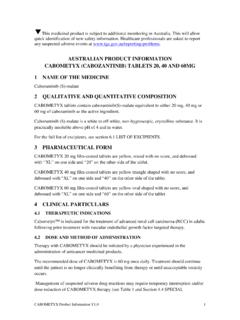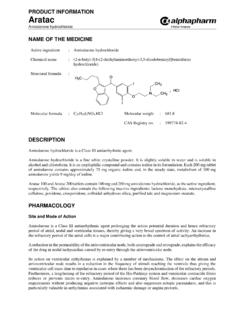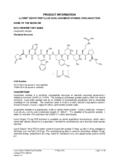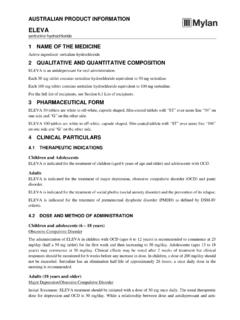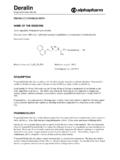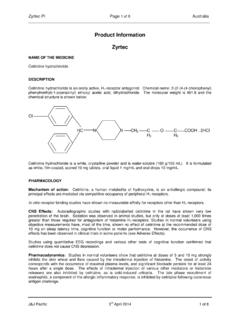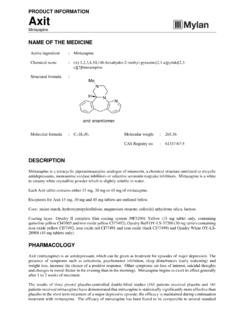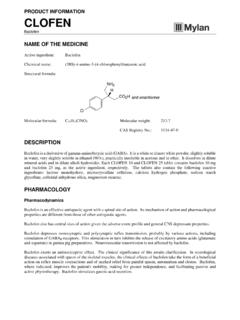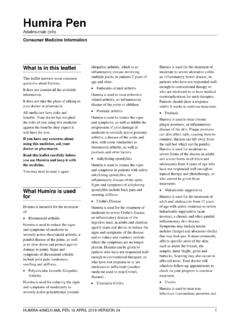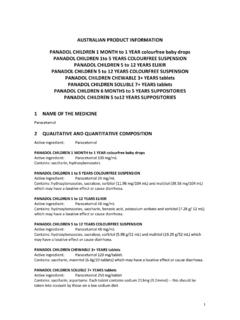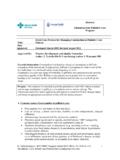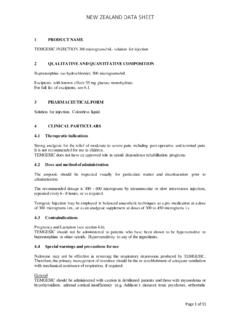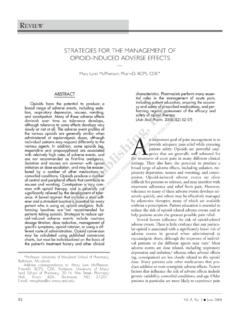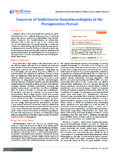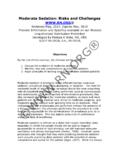Transcription of PRODUCT INFORMATION Codapane Forte - …
1 PRODUCT INFORMATION Codapane Forte Paracetamol and codeine phosphate hemihydrate NAME OF THE MEDICINE Active ingredient : Paracetamol Chemical name : N-(4-Hydroxyphenyl)acetamide Structural formula : Molecular formula : C8H9NO2 Molecular weight : CAS Registry no. : 103-90-2 Active ingredient : Codeine phosphate hemihydrate Chemical name : 7,8-Didehydro-4,5 -epoxy-3-methoxy-17-methylmorphinan-6 -ol phosphate hemihydrate Structural formula : Molecular formula : C18H24NO7P, H2O Molecular weight : CAS Registry no. : 41444-62-6 Codapane Forte PRODUCT INFORMATION 2 DESCRIPTION Paracetamol is a white crystalline powder, sparingly soluble in water, freely soluble in alcohol, very slightly soluble in ether and in methylene chloride.
2 Codeine phosphate hemihydrate appears as white, crystalline powder or small colourless crystals, freely soluble in water, slightly soluble in alcohol, practically insoluble in ether. Codapane Forte tablets contain 500 mg of paracetamol (present as Compap L ) and 30 mg of codeine phosphate hemihydrate as the active ingredients. Codapane Forte tablets also contain the following inactive ingredients: crospovidone, colloidal anhydrous silica, sodium lauryl sulfate, stearic acid and magnesium stearate. PHARMACOLOGY Analgesic and antipyretic: There is evidence to suggest that a combination of paracetamol with codeine is superior in analgesic action to either drug administered alone. Pharmacokinetics Paracetamol Absorption After oral administration, paracetamol is absorbed rapidly and completely from the small intestine; peak plasma levels occur 15 to 75 minutes after administration.
3 These results are not significantly different to those of Panadeine Forte . Food intake delays paracetamol absorption. Distribution Paracetamol is uniformly distributed throughout most body fluids; the apparent volume of distribution is 1 to L/kg. Paracetamol can cross the placenta and is excreted in milk. Plasma protein binding is negligible at usual therapeutic concentrations but increases with increasing concentrations. Metabolism Paracetamol is metabolised by the hepatic microsomal enzyme system. In adults, at therapeutic doses paracetamol is mainly conjugated with glucuronide (45 - 55%) or sulfate (20 - 30%). A minor proportion (less than 20%) is metabolised to catechol derivatives, and mercapturic acid compounds via oxidation.
4 Paracetamol is metabolised differently by infants and children compared to adults, the sulfate conjugate being predominant. Excretion Paracetamol is excreted in the urine mainly as the glucuronide and sulphate conjugates. Less than 5% is excreted as unchanged paracetamol with 85 - 90% of the administered dose eliminated in the urine within 24 hours of ingestion. The elimination half-life varies from 1 to 4 hours. Codeine Codeine has about one-sixth of the analgesic activity of morphine. It is well absorbed from the gastrointestinal tract and does not interfere with paracetamol absorption. It is metabolised in the liver to morphine and norcodeine. patients who metabolise drugs poorly via CYP2D6 are likely to obtain reduced benefit from codeine due to reduced formation of the active metabolite.
5 Codeine and its metabolites are excreted in the urine, partly as conjugates with glucuronic acid. Excretion is almost complete within 24 hours. Codapane Forte PRODUCT INFORMATION 3 INDICATIONS Relief of moderate to severe pain, and fever. CONTRAINDICATIONS Codapane Forte must not be used in patients with known hypersensitivity to paracetamol, codeine or any of the excipients used in this PRODUCT . Codapane Forte must not be used in patients with known glucose-6-phosphate-dehydrogenase deficiency or pre-existing respiratory depression, for example acute asthma, acute exacerbations of chronic obstructive pulmonary disease (COPD) since codeine may exacerbate the condition. Paracetamol should not be used in patients with a history of intolerance to the drug.
6 Paracetamol should not be used in patients with severe hepatocellular insufficiency. Due to codeine s structural similarity to morphine and oxycodone, patients experiencing systemic allergy (generalised rash, shortness of breath) to these drugs should not receive codeine. Codeine is contraindicated in patients with diarrhoea caused by poisoning, until the toxic substance has been eliminated from the gastrointestinal tract, or diarrhoea associated with pseudomembranous colitis caused by antibiotic administration since codeine may slow the elimination of the toxic material or antibiotic. Paracetamol should not be used in patients with active alcoholism as chronic excessive alcohol ingestion predisposes patients to paracetamol hepatotoxicity.
7 Codeine is contraindicated in the events of impending childbirth or in case of risk of premature birth (see PRECAUTIONS Use in Pregnancy). Codapane Forte is contraindicated during breast-feeding (see PRECAUTIONS Use in Lactation). Codapane Forte is contraindicated for use in patients who are: younger than 12 years (see PRECAUTIONS Paediatric Use). aged between 12 18 years in whom respiratory function might be compromised, including post tonsillectomy and / or adenoidectomy for obstructive sleep apnoea, due to an increased risk of developing serious and life-threatening adverse reactions (see PRECAUTIONS Paediatric Use) Codapane Forte is contraindicated for use in patients who are CYP2D6 ultra-rapid metabolisers (see PRECAUTIONS CYP2D6 metabolism).
8 PRECAUTIONS Codapane Forte should be administered with caution to patients with renal or hepatic dysfunction, viral hepatitis, and to patients taking other drugs which affect the liver. Hepatotoxicity may occur with paracetamol even at therapeutic doses, after short treatment duration and in patients without pre-existing liver dysfunction. In view of the increased risk of hepatotoxicity, the benefit should be weighed against the risk when administering Codapane Forte to patients with viral hepatitis or pre-existing hepatic disease. In such patients , hepatic function determinations may be required at periodic intervals during high dose or long-term therapy. To avoid the risk of overdose, check that paracetamol is absent from the composition of other medicinal products taken concomitantly.
9 Caution is advised in patients with underlying sensitivity to aspirin and/or to non-steroidal anti-inflammatory drugs (NSAIDs).* Codapane Forte PRODUCT INFORMATION 4 Severe cutaneous adverse reactions (SCARs): Life-threatening cutaneous reactions Stevens-Johnson syndrome (SJS), and Toxic epidermal necrolysis (TEN) have been reported with the use of paracetamol. patients should be advised of the signs and symptoms and monitored closely for skin reactions. If symptoms or signs of SJS and TEN ( progressive skin rash often with blisters or mucosal lesions) occur, patients should stop paracetamol treatment immediately and seek medical advice. Paracetamol should be used with caution in patients with: recent cessation of alcohol intake low glutathione reserves Gilbert s syndrome Codeine should be used with caution in patients with CNS depression or decreased respiratory reserve in emphysema, kyphoscoliosis, hypoxia, hypercapnia or even severe obesity or cor pulmonale, or chronic obstructive pulmonary disease (COPD).
10 Codeine should be administered with caution in patients with impaired cardiac, hepatic or renal function, and in cases of benign prostatic hyperplasia, urethral stenosis, chronic colitis ulcerative, gall bladder conditions, multiple sclerosis, hypothyroidism, adrenocortical insufficiency ( Addison s disease), shock, myxoedema, acute alcohol intoxication or delirium tremens since codeine may exacerbate the symptoms or increase the risk of respiratory and/or CNS depression. Codeine should be administered with great caution in patients with head injury, brain tumour or increased intracranial pressure since codeine may increase the risk of respiratory depression and further elevate intracranial pressure. In addition codeine can produce side effects such as confusion, miosis and vomiting which are important signs in following the clinical course of patients with head injuries.
